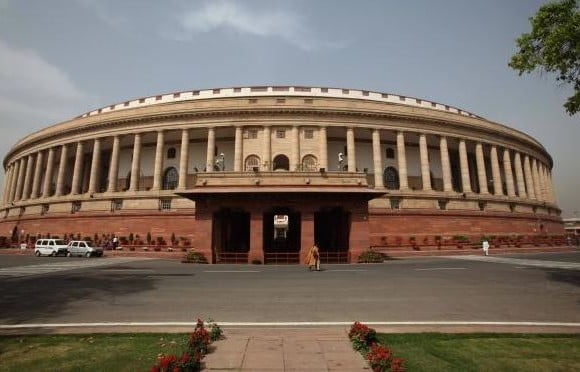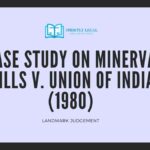The total number of amendments in the Indian Constitution: As of Jan 2020 there have been 104 amendments of the Constitution of India since it was first enacted in 1950.
First Amendments in Indian Constitution: First Amendment in the Indian Constitution was enacted by Parliament on 18 June 1951. This amendment added made several changes along with Article 15(4)[social economically backward class provisions], Article 19(6), and brought changes in the right to property in pursuance with the decision of supreme court concerning fundamental rights.
It also inserted Ninth Schedule to the Constitution to protect the land reform and other laws present in it from the judicial reviews like the Abolition of Zamindars. This amendment was made to remove difficulties created by several decisions of the Supreme Court of India, like in Romesh Thapper Vs. State of Madras AIR 1950 SC 124; Brij Bhushan Vs. State of Delhi AIR 1950 SC 129 and Moti Lal Vs. State of Uttar Pradesh AIR 1951 All. 257.
Recent Amendment: “Citizenship Amendment Act“ this was passed by the Parliament of India on 11 December 2019
It amended the Citizenship Act, 1955 by providing a path to Indian citizenship for illegal migrants of Hindu, Sikh, Buddhist, Jain, Parsi, and Christian religious minorities, who had fled persecution from neighboring countries of India before December 2014. Here Muslims from those countries were not given such eligibility. The act was the first time religion had been overtly used as a criterion for citizenship under Indian law.
INTRODUCTION: Like any other written Constitution in the world, the Constitution of Institution provides its adjust itself by changing itself through Amendments. However it is not as easy as in Britain, nor as tough as the U.S. Constitution. Indian Constitution is neither so flexible nor so rigid but a composition of both.
Article 368 of Part XX of the Indian Constitution deals with the powers of parliament to amend the constitution and its procedure.
The framers of the Indian constitution were keen to avoid excess rigidity. They were anxious to have the document which could grow with the nation, adapts itself to the changing need and circumstances of a growing people.
Late Prime Minister Pt. Nehru, “While we want this Constitution be as solid and permanent as we can make it, there is no permanence in the Constitution. There should be a certain flexibility. If you make anything rigid and permanent you stop the nation’s growth, of a living, vital, organic people………… In any event, we could not make this Constitution so rigid that it cannot be adopted to changing conditions. When the word is in a period of transition what we may do today may not be wholly applicable tomorrow”.
Table of Contents
Types of Amendments:
Article 368 of the Indian Constitution mentions two types of amendments to the Indian Constitution.
- The amendment by a special majority of the Parliament (Lok Sabha & Rajya Sabha) and
- Secondly, The amendment is by a special majority of the Parliament with the ratification by half of the states by a simple majority.
But, some other articles provide for the amendment of certain provisions of the Constitution by a simple majority of Parliament i.e. a majority of the members of each of the house present and voting (similar to an ordinary legislative process).
Notably, these amendments are not deemed to be amendments of the Constitution for the purpose of the Article 368. Therefore, the Constitution can be amended in three ways:
a. Amendments by a simple majority of the parliament: The amendments considered in Article 5, 169, and Article 239-A can be made by a simple majority. These Articles are specifically excluded from the purview of the procedure prescribed in Article 368.
b. Amendments by a special majority of the Parliament: Articles of the Constitution which can be amended by the special majority as laid down in Article 368. All constitutional amendments, other than those referred to above, come within this category and must be effected by a majority of the total membership of each House of Parliament as well as by a majority of not less than 2/3 of the members of that House present and voting.
c. Amendments by a special majority of the parliament and the ratification of the state legislature.: The article which require, in addition to the special majority mentioned above, ratification by not less than 1/2 of the State Legislatures. The States are given an important voice in the amendment of these matters. These are fundamental matters where States have important power under the Constitution and any unilateral amendment by Parliament may vitally affect the fundamental basis of the system built up by the Constitution. This class of Articles consists of amendments that seek to make any change in the provisions mentioned in Article 368. The following provisions require such ratification by the States :
1. Election of the President-Articles 54 and 55.
2. Extent of the Executive powers of the Union and States-Articles 73 and 162, Article 241 or 279-A.
3. Articles dealing with judiciary, Supreme Court, High Court in the States and Union territories-Articles 124 to 147, 214 to 231, 241.
4. Distribution of Legislative powers between the Center and the State- Articles 245 to 255.
5. Goods and Service Tax Council-Article 279A.
6. Any of the Lists of the 7th Schedule.
7. Representation of States in Parliament 4th Schedule.
8. Article 368 itself.
The Second and third type of amendments are governed by Article 368.
The procedure of Amendments:
Article 368 of our Indian Constitution deals with the powers of parliament to amend the constitution and its procedure and those procedures are as follows:
- an amendment of the Indian Constitution can only be initiated by introducing a bill for any purpose from either house of the parliament and not in the state legislature.
- The bill can be introduced either by a minister or by a private member and does not require prior permission to the president.
- The bill must pass in each House by a special majority that is, a majority of the total membership of the House and a majority of two-thirds of the members of the House present and voting.
- Each House must pass the bill separately. In case of disagreement between two the house for the purpose of deliberation and passage of the bill.
- If the bill seeks to amend the federal provisions of the Constitution, it must also be ratified by the legislatures of half of the states by a simple majority, that is a majority of the members of the House present and voting.
- After duly passed by both the Houses of Parliament and ratified by the State legislatures of half of the state legislature, where necessary, the bill is presented to the president assent.
- The President must give his assent to the bill. He can neither withhold his assent to the bill nor return the bill for the reconsideration of the Parliament.
- After the president’s assent, the bill becomes an Act (i.e., a constitutional amendment act) and the constitution stands amended in accordance with the terms of the Act.
The necessity of Amending provisions in the Constitution:
There is a reason why Dr. B. R. Ambedkar made the constitution as flexible as it is today. This is to ensure that the document evolves and grows along with the nation. Thus, under Article 368, the powers of the Parliament to amend the constitution is unrestricted with regards to sections of the constitution they wish to amend.
But the Parliament having absolute power over amending the constitution is dangerous. Instead of being the backbone of our democracy, the constitution will be reduced to a tool to establish Parliament’s totalitarianism. The government will amend various provisions to make sure it’s powers are free.
While this is a scary thought, it is not far away from the truth. The government in multiple amendments such as the 39th Amendment and in the second clause of the 25th Amendment has tried to establish a state where the legislative is supreme.
That is why the judiciary through various landmark cases has established The Basic Structure Doctrine of The Indian Constitution.
What is the Basic Structure?
The Basic Structure Doctrine states there are certain fundamental structures and founding principles of the constitution which make the backbone of the constitution. In simple terms, they are ideologies of the constitution which are essential for the survival of the constitution. Some examples are Free and Fair Election, the Federal nature of the Nation, Judicial review and Separation of Power. The government is restricted from touching these contours of the constitution through amendment.
The Supreme Court has not given us a list of these ideologies. It is up to the courts to decide what they are when certain judicial questions are presented before them. But if one wants to describe the nature of the structures, it can be said that if these ideologies are violated, then not only democracy but the entire working of this country will fall flat on its face. The country will either fall into total anarchy or totalitarianism. It is because of these mechanisms that India is still one of the largest democracies in the world.
Thus, while Parliament has unrestricted powers to amend various sections of the constitution, but they cannot touch amend, repeal or add sections into the constitution which would affect its basic structure in the process.
The Most famous case to understand this concept: Keshavananda Bharati v.State of Kerala
Criticism of the amendment procedure:
The critics have criticized the amendment procedure of the Constitution on the following grounds:
1. There is no provision for a special body like Constitutional Convention (as in the USA) or Constitutional Assembly for amending the Constitution. The constituent power is vested in the Parliament and only in few cases, in the state legislatures.
2. The power to initiate an amendment to the Constitution lies with the Parliament. Hence, unlike in USA9, the state legislatures cannot initiate any bill or proposal for amending the Constitution except in one case, that is, passing a resolution requesting the Parliament for the creation or abolition of legislative councils in the states. Here also, the Parliament can either approve or disapprove such a resolution or may not take any action on it.
3. A major part of the Constitution can be amended by the Parliament alone either by a special majority or by a simple majority. Only in a few cases, the consent of the state legislatures is required and that too, only half of them, while in the USA, it is three-fourths of the states.
4. The Constitution does not prescribe the time frame within which the state legislatures should ratify or reject an amendment submitted to them. Also, it is silent on the issue whether the states can with-draw their approval after according the same.
5. There is no provision for holding a joint sitting of both the Houses of Parliament if there is a deadlock over the passage of a constitutional amendment bill. On the other hand, a provision for a joint sitting is made in the case of an ordinary bill.
6. The process of amendment is similar to that of a legislative process. Except for the special majority, the constitutional amendment bills are to be passed by the Parliament in the same way as ordinary bills.
7. The provisions relating to the amendment procedure are too sketchy. Hence, they leave a wide scope for taking matters to the judiciary.
Despite these defects, it cannot be denied that the process has proved to be simple and easy and has succeeded in meeting the changing needs and conditions. The procedure is not so flexible as to allow the ruling parties to change it according to their whims. Nor is it so rigid as to be incapable of adapting itself to the changing needs.
K.C. Wheare an Australian academic says ” strikes a good balance between flexibility and Rigidity”. He admires the variety of amendment procedure and said “this variety of amendments is wise and rarely found”
Dr. B. R. Ambedkar says “
The Assembly has not only refrained from
putting a seal of finality and infallibility upon this Constitution as in Canada
or by making the amendment of the Constitution subject to the fulfillment
of extraordinary terms and conditions as in America or Australia, but has
provided a most facile procedure for amending the Constitution.“
Is the Theory of Basic Structure a limitation on Amending Power?
Well, there are some limitations that the government should maintain the social&economic goals to perform certainly. To perform this duty the government amends the constitution. But if these amendments mess with the basic structure. it would affect those socio-economic duties, moreover, the state will collapse and it would be difficult to maintain the duties on the constitution.
To understand this we need to study the case of Indira Nehru Gangdhi v. Raj Narayan
Conclusions:
Through this article, we explored the amendment of the constitution. We found that there is something called the Basic Structure of the Constitution and it is against the basic principles of justice to breach it. The judiciary was at first of the opinion that the preamble was what constituted the basic structure of the constitution but later on, it was ruled that other aspects of the constitution such as judicial review could also be the aspects of the Basic Structure of the Constitution.
The government in many landmark cases tried to amend the constitution in order to make it easier to ensure the best for the public interest. The judiciary was absolutely against the whole idea, in later judgments we see the judges opening up to the idea of the executive being able to override certain aspects of the basic structure in order to ensure the best for the public interest. But later on, judgments, unless the judiciary was absolutely convinced that such Acts would be beneficial in ensuring greater public welfare, they were strict about amendments that violated the basic structure.
What we must realize is that the constitution is the backbone of this democracy. While it was revolutionary of the fathers of our constitution to provide provisions to amend the constitution, it is essential that such provisions are not misused. Misuse could result in excessive power of the legislative or the executive which could tear the fabric of our democracy.
Relevant Cases with their links:
Shankari Prasad v. Union of India
Sajjan Singh v. State of Rajesthan
Indira Nehru Gangdhi v. Raj Narayan
Keshavananda Bharati v.State of Kerala
From this case the Supreme Court added some basic features in the Constitution :
- Rule of law,
- Judicial Review
- Democracy, which implied free and fair election.
It has been held that the jurisdiction of the Supreme Court under Article 32 is the basic features of the Constitution.
Minerva Mills Ltd v. Union of India Supreme Court has held that the following are the basic features of the Constitution :
1. limited power of Parliament to amend the Constitution;
2. harmony and balance between fundamental rights and directive principles;
3. fundamental rights in certain cases;
4. power of judicial review in certain cases. Independence of the judiciary is part of the basic structure.
The “basic Structure” is truly a set of fundamental foundational principles, drawn from the provisions of the Constitution itself. They are not fanciful principles carved out by the judiciary, on its own.
S.P. Sampat Kumar v. Union of India
L. Chandra Kumar v. Union of India
I.R. Coelho v. State of Tamil Nadu
Ajit Singh Virpal Singh v. State of Punjab
Important amendments act:
(chart ta chipkiye dis …ami parlamna)
Contributions such as these help us build and sustain a community of curious minds. We welcome Contributors to Sign up on our website through this link and send us their articles or blog posts.
Striving to create a community of like minds,
team SL,

Trying to learn the art of advocacy.
Practicing at the Calcutta High Court and in its vicinity.





